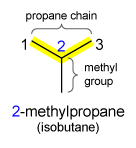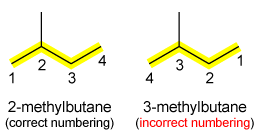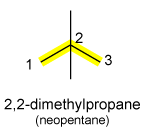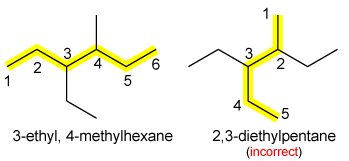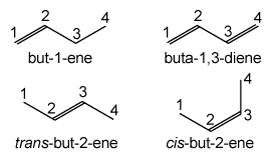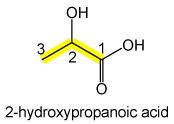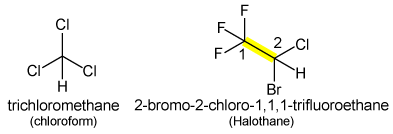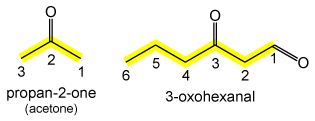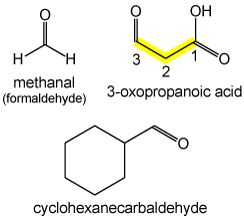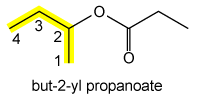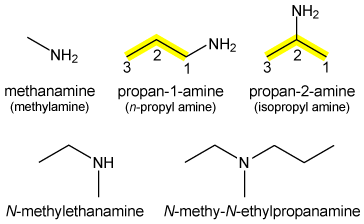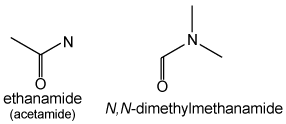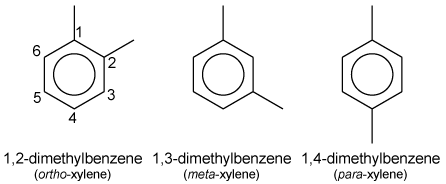IUPAC nomenclature of organic chemistry: Difference between revisions
imported>Milton Beychok m (→Ketones: Added another original image uploaded from Commons.) |
mNo edit summary |
||
| (16 intermediate revisions by 3 users not shown) | |||
| Line 1: | Line 1: | ||
{{subpages}} | {{subpages}} | ||
The '''IUPAC nomenclature of organic chemistry''' is a [[systematic name|systematic]] way of naming [[Organic compound|organic chemical compound]]s as recommended by the [[International Union of Pure and Applied Chemistry]] (IUPAC). Ideally, every organic [[chemical compound|compound]] should have a name from which an unambiguous [[structural formula]] can be drawn. There is also an [[IUPAC nomenclature of inorganic chemistry]]. See also [[phanes]] nomenclature of highly complex cyclic molecules. | The '''IUPAC nomenclature of organic chemistry''' is a [[systematic name|systematic]] way of naming [[Organic compound|organic chemical compound]]s as recommended by the [[International Union of Pure and Applied Chemistry]] (IUPAC).<ref>{{cite book |author= The Commission on the Nomenclature of Organic Chemistry |title= Nomenclature of Organic Chemistry|edition=3rd edition |year=1971|publisher= Butterworths |id=ISBN 0-408-70144-7}}</ref><ref>[http://www.acdlabs.com/iupac/nomenclature/ IUPAC Nomenclature of Organic Chemistry] (online version of the IUPAC "Blue Book")</ref><ref>{{cite book|author=Dieter Hellwinkle|title=Systematic Nomenclature of Organic Chemistry|edition=1st Edition|publisher=Springer-Verlag|year=2001|id=ISBN 3-540-41138-0}}</ref> Ideally, every organic [[chemical compound|compound]] should have a name from which an unambiguous [[structural formula]] can be drawn. There is also an [[IUPAC nomenclature of inorganic chemistry]]. See also [[phanes]] nomenclature of highly complex cyclic molecules. | ||
For ordinary communication, to spare a tedious description, the official IUPAC naming recommendations are not always followed in practice except when it is necessary to give a concise definition to a compound, or when the IUPAC name is simpler (viz. ethanol against ethyl alcohol). Otherwise the common or [[trivial name]] may be used, often derived from the source of the compound (See Sec 14. below) | For ordinary communication, to spare a tedious description, the official IUPAC naming recommendations are not always followed in practice except when it is necessary to give a concise definition to a compound, or when the IUPAC name is simpler (viz. ethanol against ethyl alcohol). Otherwise the common or [[trivial name]] may be used, often derived from the source of the compound (See Sec 14. below) | ||
This article has not had any substantive checking since being transferred from Wikipedia in 2006. It needs a <BR>detailed, critical review. See Talk page. | |||
== Basic principles == | == Basic principles == | ||
In IUPAC nomenclature, a number of [[Prefix (linguistics)|prefix]]es, [[Affix|suffixes]] and [[infix]]es are used to describe the type and position of [[functional group]]s in the compound. | In IUPAC nomenclature, a number of [[Prefix (linguistics)|prefix]]es, [[Affix|suffixes]] and [[infix]]es are used to describe the type and position of [[functional group]]s in the compound. | ||
| Line 27: | Line 28: | ||
==[[Alkane]]s== | ==[[Alkane]]s== | ||
Straight-chain alkanes take the suffix "-ane" and are prefixed depending on the number of carbon atoms in the chain, as given by the following table: | Straight-chain alkanes take the suffix "-ane" and are prefixed depending on the number of carbon atoms in the chain, as given by the following table: | ||
| Line 60: | Line 60: | ||
==[[Alkene]]s and [[Alkyne]]s== | ==[[Alkene]]s and [[Alkyne]]s== | ||
{{Image|IUPAC-alkene.png|right|269px|}} | {{Image|IUPAC-alkene.png|right|269px|}} | ||
Alkenes are named for their parent alkane chain with the suffix "-ene" and an infixed number indicating the position of the double-bonded carbon in the chain: CH<sub>2</sub>=CHCH<sub>2</sub>CH<sub>3</sub> is but-1-ene. Ethene ([[ethylene]]) and propene ([[propylene]]) do not require infixed numbers, since there is no ambiguity in the structures. As before, the lowest number is used. | Alkenes are named for their parent alkane chain with the suffix "-ene" and an infixed number indicating the position of the double-bonded carbon in the chain: CH<sub>2</sub>=CHCH<sub>2</sub>CH<sub>3</sub> is but-1-ene. Ethene ([[ethylene]]) and propene ([[propylene]]) do not require infixed numbers, since there is no ambiguity in the structures. As before, the lowest number is used. | ||
| Line 70: | Line 69: | ||
==[[Alcohol]]s== | ==[[Alcohol]]s== | ||
{{Image|IUPAC-alcohol-1.png|right|350px|}} | {{Image|IUPAC-alcohol-1.png|right|350px|}} | ||
Alcohols (R-OH) drop the terminal "e" from the name of the parent alkane, and take the suffix "-ol" with an infix numerical bonding position: CH<sub>3</sub>CH<sub>2</sub>CH<sub>2</sub>OH is propan-1-ol. ([[Methanol]] and [[ethanol]] are unambiguous and do not require position numbers). The suffixes -diol, -triol, -tetraol, etc., are used for multiple -OH groups: [[Ethylene glycol]] CH<sub>2</sub>OHCH<sub>2</sub>OH is ethan-1,2-diol. | Alcohols (R-OH) drop the terminal "e" from the name of the parent alkane, and take the suffix "-ol" with an infix numerical bonding position: CH<sub>3</sub>CH<sub>2</sub>CH<sub>2</sub>OH is propan-1-ol. ([[Methanol]] and [[ethanol]] are unambiguous and do not require position numbers). The suffixes -diol, -triol, -tetraol, etc., are used for multiple -OH groups: [[Ethylene glycol]] CH<sub>2</sub>OHCH<sub>2</sub>OH is ethan-1,2-diol. | ||
| Line 78: | Line 76: | ||
==[[Halogens]] (Alkyl Halides)== | ==[[Halogens]] (Alkyl Halides)== | ||
{{Image|IUPAC-halogen.png|right|393px|}} | |||
[[Halogen]] functional groups are prefixed with the bonding position and take the form fluoro-, chloro-, bromo-, iodo-, etc., depending on the halogen. Multiple groups are dichloro-, trichloro-, etc, and disimilar groups are orded alphabetically as before. For example, CHCl<sub>3</sub> ([[chloroform]]) is trichloromethane. The anesthetic [[Halothane]] (CF<sub>3</sub>CHBrCl) is 2-bromo-2-chloro-1,1,1-trifluoroethane. <br clear="all"> | [[Halogen]] functional groups are prefixed with the bonding position and take the form fluoro-, chloro-, bromo-, iodo-, etc., depending on the halogen. Multiple groups are dichloro-, trichloro-, etc, and disimilar groups are orded alphabetically as before. For example, CHCl<sub>3</sub> ([[chloroform]]) is trichloromethane. The anesthetic [[Halothane]] (CF<sub>3</sub>CHBrCl) is 2-bromo-2-chloro-1,1,1-trifluoroethane. <br clear="all"> | ||
==[[Ketone]]s== | ==[[Ketone]]s== | ||
{{Image|IUPAC-ketone.png|left|315px|}} | {{Image|IUPAC-ketone.png|left|315px|}} | ||
In general ketones (R-CO-R) take the suffix "-one" (pronounced ''own'', not ''won'') with an infix position number: CH<sub>3</sub>CH<sub>2</sub>CH<sub>2</sub>COCH<sub>3</sub> is pentan-2-one. For common ketones some traditional names such as [[acetone]] and [[benzophenone]] predominate, and these are [http://www.acdlabs.com/iupac/nomenclature/93/r93_701.htm acceptable IUPAC names], although some introductory chemistry texts use alternative names for acetone such as propan-2-one or propanone (see diagram). Additionally, in such | In general ketones (R-CO-R) take the suffix "-one" (pronounced ''own'', not ''won'') with an infix position number: CH<sub>3</sub>CH<sub>2</sub>CH<sub>2</sub>COCH<sub>3</sub> is pentan-2-one. For common ketones some traditional names such as [[acetone]] and [[benzophenone]] predominate, and these are [http://www.acdlabs.com/iupac/nomenclature/93/r93_701.htm acceptable IUPAC names], although some introductory chemistry texts use alternative names for acetone such as propan-2-one or propanone (see diagram). Additionally, in such unambiguous cases as propanone, the infixed number can be dropped. If a higher precedence suffix is in use, the prefix "oxo-" is used: CH<sub>3</sub>CH<sub>2</sub>CH<sub>2</sub>COCH<sub>2</sub>CHO is 3-oxohexanal. <br clear="all"> | ||
==[[Aldehyde]]s== | ==[[Aldehyde]]s== | ||
{{Image|IUPAC-aldehyde.png|right|244px|}} | |||
Aldehydes (R-CHO) take the suffix "-al". Since they are always at the end of an alkane chain, they do not need a position number: HCHO ([[formaldehyde]]) is methanal, CH<sub>3</sub>CHO ([[acetaldehyde]]) is ethanal. If other functional groups are present, the chain is numbered such that the aldehyde carbon is in the "1" position. | Aldehydes (R-CHO) take the suffix "-al". Since they are always at the end of an alkane chain, they do not need a position number: HCHO ([[formaldehyde]]) is methanal, CH<sub>3</sub>CHO ([[acetaldehyde]]) is ethanal. If other functional groups are present, the chain is numbered such that the aldehyde carbon is in the "1" position. | ||
| Line 95: | Line 90: | ||
==[[Carboxylic acid]]s== | ==[[Carboxylic acid]]s== | ||
{{Image|IUPAC-carboxyl.png||106px|}} | |||
In general carboxylic acids are named with the suffix ''-oic acid'' (etymologically a [[back-formation]] from [[benzoic acid]]). As for aldehydes, they take the "1" position on the parent chain, but do not have their position number indicated. For example, CH<sub>3</sub>CH<sub>2</sub>CH<sub>2</sub>CH<sub>2</sub>COOH (valeric acid) is named pentanoic acid. For common carboxylic acids some traditional names such as [[acetic acid]] are in such widespread use they are considered [http://www.acdlabs.co.uk/iupac/nomenclature/93/r93_705.htm retained IUPAC names], although "systematic" names such as ethanoic acid are also acceptable. For carboxylic acids attached to a benzene ring such as [[Phenyl|Ph]]-COOH, these are named as benzoic acid or its derivatives. | In general carboxylic acids are named with the suffix ''-oic acid'' (etymologically a [[back-formation]] from [[benzoic acid]]). As for aldehydes, they take the "1" position on the parent chain, but do not have their position number indicated. For example, CH<sub>3</sub>CH<sub>2</sub>CH<sub>2</sub>CH<sub>2</sub>COOH (valeric acid) is named pentanoic acid. For common carboxylic acids some traditional names such as [[acetic acid]] are in such widespread use they are considered [http://www.acdlabs.co.uk/iupac/nomenclature/93/r93_705.htm retained IUPAC names], although "systematic" names such as ethanoic acid are also acceptable. For carboxylic acids attached to a benzene ring such as [[Phenyl|Ph]]-COOH, these are named as benzoic acid or its derivatives. | ||
| Line 103: | Line 97: | ||
==[[Ether (chemistry)|Ether]]s== | ==[[Ether (chemistry)|Ether]]s== | ||
{{Image|IUPAC-ether.png|right|405px|}} | |||
Ethers (R-O-R) consist of an oxygen atom between the two attached carbon chains. The shorter of the two chains becomes the first part of the name with the -ane suffix changed to -oxy, and the longer alkane chain become the suffix of the name of the ether. Thus CH<sub>3</sub>OCH<sub>3</sub> is methoxymethane, and CH<sub>3</sub>OCH<sub>2</sub>CH<sub>3</sub> is methoxyethane (''not'' ethoxymethane). If the oxygen is not attached to the end of the main alkane chain, then the whole shorter alkyl-plus-ether group is treated as a side-chain and prefixed with its bonding position on the main chain. Thus CH<sub>3</sub>OCH(CH<sub>3</sub>)<sub>2</sub> is 2-methoxypropane. <br clear="all"> | Ethers (R-O-R) consist of an oxygen atom between the two attached carbon chains. The shorter of the two chains becomes the first part of the name with the -ane suffix changed to -oxy, and the longer alkane chain become the suffix of the name of the ether. Thus CH<sub>3</sub>OCH<sub>3</sub> is methoxymethane, and CH<sub>3</sub>OCH<sub>2</sub>CH<sub>3</sub> is methoxyethane (''not'' ethoxymethane). If the oxygen is not attached to the end of the main alkane chain, then the whole shorter alkyl-plus-ether group is treated as a side-chain and prefixed with its bonding position on the main chain. Thus CH<sub>3</sub>OCH(CH<sub>3</sub>)<sub>2</sub> is 2-methoxypropane. <br clear="all"> | ||
==[[Ester]]s== | ==[[Ester]]s== | ||
{{Image|IUPAC-ester-1.png|left|405px|}} | |||
Esters (R-CO-O-R') are named as alkyl derivatives of carboxylic acids. The alkyl (R') group is named first. The R-CO-O part is then named as a separate word based on the carboxylic acid name, with the ending changed from ''oic acid'' to ''oate''. For example, CH<sub>3</sub>CH<sub>2</sub>CH<sub>2</sub>CH<sub>2</sub>COOCH<sub>3</sub> is ''methyl pentanoate'', and (CH<sub>3</sub>)<sub>2</sub>CHCH<sub>2</sub>CH<sub>2</sub>COOCH<sub>2</sub>CH<sub>3</sub> is ''ethyl 4-methylpentanoate''. For esters such as [[ethyl acetate]] (CH<sub>3</sub>COOCH<sub>2</sub>CH<sub>3</sub>), [[ethyl formate]] (HCOOCH<sub>2</sub>CH<sub>3</sub>) or dimethyl phthalate that are based on common acids, IUPAC recommends use of these established names, called [http://www.acdlabs.co.uk/iupac/nomenclature/93/r93_511.htm retained names]. Some simple examples, named both ways, are shown in the figure above. | Esters (R-CO-O-R') are named as alkyl derivatives of carboxylic acids. The alkyl (R') group is named first. The R-CO-O part is then named as a separate word based on the carboxylic acid name, with the ending changed from ''oic acid'' to ''oate''. For example, CH<sub>3</sub>CH<sub>2</sub>CH<sub>2</sub>CH<sub>2</sub>COOCH<sub>3</sub> is ''methyl pentanoate'', and (CH<sub>3</sub>)<sub>2</sub>CHCH<sub>2</sub>CH<sub>2</sub>COOCH<sub>2</sub>CH<sub>3</sub> is ''ethyl 4-methylpentanoate''. For esters such as [[ethyl acetate]] (CH<sub>3</sub>COOCH<sub>2</sub>CH<sub>3</sub>), [[ethyl formate]] (HCOOCH<sub>2</sub>CH<sub>3</sub>) or dimethyl phthalate that are based on common acids, IUPAC recommends use of these established names, called [http://www.acdlabs.co.uk/iupac/nomenclature/93/r93_511.htm retained names]. Some simple examples, named both ways, are shown in the figure above. | ||
{{Image|IUPAC-ester-2.png|right|199px|}} | |||
If the alkyl group is not attached at the end of the chain, the bond position to the ester group is infixed before "-yl": CH<sub>3</sub>CH<sub>2</sub>CH(CH<sub>3</sub>)OOCCH<sub>2</sub>CH<sub>3</sub> may be called but-2-yl propanoate or but-2-yl propionate. | If the alkyl group is not attached at the end of the chain, the bond position to the ester group is infixed before "-yl": CH<sub>3</sub>CH<sub>2</sub>CH(CH<sub>3</sub>)OOCCH<sub>2</sub>CH<sub>3</sub> may be called but-2-yl propanoate or but-2-yl propionate. | ||
==[[Amine]]s and [[Amide]]s== | ==[[Amine]]s and [[Amide]]s== | ||
{{Image|IUPAC-amine.png|left|364px|}} | |||
Amines (R-NH<sub>2</sub>) are named for the attached alkane chain with the suffix "-amine" (e.g. CH<sub>3</sub>NH<sub>2</sub> methanamine). If necessary, the bonding position is infixed: CH<sub>3</sub>CH<sub>2</sub>CH<sub>2</sub>NH<sub>2</sub> propan-1-amine, CH<sub>3</sub>CHNH<sub>2</sub>CH<sub>3</sub> propan-2-amine. The prefix form is "amino-". | Amines (R-NH<sub>2</sub>) are named for the attached alkane chain with the suffix "-amine" (e.g. CH<sub>3</sub>NH<sub>2</sub> methanamine). If necessary, the bonding position is infixed: CH<sub>3</sub>CH<sub>2</sub>CH<sub>2</sub>NH<sub>2</sub> propan-1-amine, CH<sub>3</sub>CHNH<sub>2</sub>CH<sub>3</sub> propan-2-amine. The prefix form is "amino-". | ||
For secondary amines (of the form R-NH-R), the longest carbon chain attached to the nitrogen atom becomes the primary name of the amine; the other chain is prefixed as an alkyl group with location prefix given as an italic ''N'': CH<sub>3</sub>NHCH<sub>2</sub>CH<sub>3</sub> is ''N''-methylethanamine. Tertiary amines (R-NR-R) are treated similarly: CH<sub>3</sub>CH<sub>2</sub>N(CH<sub>3</sub>)CH<sub>2</sub>CH<sub>2</sub>CH<sub>3</sub> is ''N''-methyl-''N''-ethylpropanamine. | For secondary amines (of the form R-NH-R), the longest carbon chain attached to the nitrogen atom becomes the primary name of the amine; the other chain is prefixed as an alkyl group with location prefix given as an italic ''N'': CH<sub>3</sub>NHCH<sub>2</sub>CH<sub>3</sub> is ''N''-methylethanamine. Tertiary amines (R-NR-R) are treated similarly: CH<sub>3</sub>CH<sub>2</sub>N(CH<sub>3</sub>)CH<sub>2</sub>CH<sub>2</sub>CH<sub>3</sub> is ''N''-methyl-''N''-ethylpropanamine. | ||
{{Image|IUPAC-amide.png|right|286px|}} | |||
Amides (R-CO-NH<sub>2</sub>) take the suffix "-amide". There is no prefix form, and no location number is required since they always terminate a carbon chain, e.g. CH<sub>3</sub>CONH<sub>2</sub> ([[acetamide]]) is named ethanamide. | Amides (R-CO-NH<sub>2</sub>) take the suffix "-amide". There is no prefix form, and no location number is required since they always terminate a carbon chain, e.g. CH<sub>3</sub>CONH<sub>2</sub> ([[acetamide]]) is named ethanamide. | ||
| Line 128: | Line 119: | ||
==Cyclic compounds== | ==Cyclic compounds== | ||
{{Image|IUPAC-cyclic.png|center|446px|}} | |||
[[Cycloalkane]]s and [[aromatic]] compounds can be treated as the main parent chain of the compound, in which case the position of substituents are numbered around the ring structure. For example, the three isomers of [[xylene]] CH<sub>3</sub>C<sub>6</sub>H<sub>4</sub>CH<sub>3</sub>, commonly the ''ortho-'', ''meta-'', and ''para-'' forms, are 1,2-dimethylbenzene, 1,3-dimethylbenzene, and 1,4-dimethylbenzene. The cyclic structures can also be treated as functional groups themselves, in which case they take the prefix "cyclo''alkyl''-" (e.g. "cyclohexyl-") or for benzene, "phenyl-". | [[Cycloalkane]]s and [[aromatic]] compounds can be treated as the main parent chain of the compound, in which case the position of substituents are numbered around the ring structure. For example, the three isomers of [[xylene]] CH<sub>3</sub>C<sub>6</sub>H<sub>4</sub>CH<sub>3</sub>, commonly the ''ortho-'', ''meta-'', and ''para-'' forms, are 1,2-dimethylbenzene, 1,3-dimethylbenzene, and 1,4-dimethylbenzene. The cyclic structures can also be treated as functional groups themselves, in which case they take the prefix "cyclo''alkyl''-" (e.g. "cyclohexyl-") or for benzene, "phenyl-". | ||
| Line 216: | Line 207: | ||
<small>*''Note'': These suffixes, in which the carbon atom is counted as part of the preceding chain, are the most commonly used. See individual functional group articles for more details.</small> | <small>*''Note'': These suffixes, in which the carbon atom is counted as part of the preceding chain, are the most commonly used. See individual functional group articles for more details.</small> | ||
==Common nomenclature - | ==Common nomenclature - trivial names== | ||
Common nomenclature is an older system of naming organic compounds. Instead of using the prefixes for the carbon skeleton above, another system is used. The pattern can be seen below. | Common nomenclature is an older system of naming organic compounds. Instead of using the prefixes for the carbon skeleton above, another system is used. The pattern can be seen below. | ||
{| border=1 cellspacing=0 cellpadding=3 | {| border=1 cellspacing=0 cellpadding=3 | ||
| Line 306: | Line 297: | ||
The name of each substitution is prepended to the hydride cation name. If many substitutions by the same functional group occur, then the number is indicated by prepending "di-", "tri-" as with halogenation. (CH<sub>3</sub>)<sub>3</sub>O<sup>+</sup> is trimethyloxonium. CH<sub>3</sub>F<sub>3</sub>N<sup>+</sup> is trifluoromethylammonium. | The name of each substitution is prepended to the hydride cation name. If many substitutions by the same functional group occur, then the number is indicated by prepending "di-", "tri-" as with halogenation. (CH<sub>3</sub>)<sub>3</sub>O<sup>+</sup> is trimethyloxonium. CH<sub>3</sub>F<sub>3</sub>N<sup>+</sup> is trifluoromethylammonium. | ||
== | == Attribution == | ||
{{WPAttribution}} | |||
== References == | == References == | ||
{{reflist}}[[Category:Suggestion Bot Tag]] | |||
Latest revision as of 16:01, 30 August 2024
The IUPAC nomenclature of organic chemistry is a systematic way of naming organic chemical compounds as recommended by the International Union of Pure and Applied Chemistry (IUPAC).[1][2][3] Ideally, every organic compound should have a name from which an unambiguous structural formula can be drawn. There is also an IUPAC nomenclature of inorganic chemistry. See also phanes nomenclature of highly complex cyclic molecules.
For ordinary communication, to spare a tedious description, the official IUPAC naming recommendations are not always followed in practice except when it is necessary to give a concise definition to a compound, or when the IUPAC name is simpler (viz. ethanol against ethyl alcohol). Otherwise the common or trivial name may be used, often derived from the source of the compound (See Sec 14. below)
This article has not had any substantive checking since being transferred from Wikipedia in 2006. It needs a
detailed, critical review. See Talk page.
Basic principles
In IUPAC nomenclature, a number of prefixes, suffixes and infixes are used to describe the type and position of functional groups in the compound.
For many compounds, naming can begin by determining the name of the parent hydrocarbon and by identifying any functional groups in the molecule that distinguish it from the parent hydrocarbon. The numbering of the parent alkane is used, as modified, if necessary, by application of the Cahn Ingold Prelog priority rules ("CIP") in the case that ambiguity remains after consideration of the structure of the parent hydrocarbon alone. The name of the parent hydrocarbon is modified by the application of the highest-priority functional group suffix, with the remaining functional groups indicated by numbered prefixes, appearing in the name in alphabetical order from first to last.
In many cases, lack of rigor in applying all such nomenclature rules still yields a name that is intelligible — the aim, of course, being to avoid any ambiguity in terms of what substance is being discussed.
For instance, strict application of CIP priority to the naming of the compound NH2CH2CH2OH would render the name as 2-aminoethanol, which is preferred. However, the name 2-hydroxyethanamine unambiguously refers to the same compound.
How the name was constructed:
- There are two carbons in the main chain; this gives the root name "eth".
- Since the carbons are singly-bonded, the suffix begins with "an".
- The two functional groups are an alcohol (OH) and an amine (NH2). The alcohol has the higher atomic number, and takes priority over the amine. The suffix for an alcohol ends in "ol", so that the suffix is "anol".
- The amine group is not on the carbon with the OH (the #1 carbon), but one carbon over (the #2 carbon); therefore we indicate its presence with the prefix "2-amino".
- Putting together the prefix, the root and the suffix, we get "2-aminoethanol".
There is also an older naming system for organic compounds known as common nomenclature, which is often used for simple, well-known compounds, and also for complex compounds whose IUPAC names are too complex for everyday use.
Simplified molecular input line entry specification (SMILES) strings are commonly used to describe organic compounds, and as such are a form of 'naming' them.
Alkanes
Straight-chain alkanes take the suffix "-ane" and are prefixed depending on the number of carbon atoms in the chain, as given by the following table:
| Number of carbons | 1 | 2 | 3 | 4 | 5 | 6 | 7 | 8 | 9 | 10 | 11 | 12 | 13 | 14 | 15 | 20 | |
|---|---|---|---|---|---|---|---|---|---|---|---|---|---|---|---|---|---|
| Prefix | Meth | Eth | Prop | But | Pent | Hex | Hept | Oct | Non | Dec | Undec | Dodec | Tridec | Tetradec | Pentadec | Eicos |
For example, the simplest alkane is CH4 methane, and the nine-carbon alkane CH3(CH2)7CH3 is named nonane.
Cyclic alkanes are simply prefixed with "cyclo-", for example C4H8 is cyclobutane and C6H12 is cyclohexane.
Branched alkanes are named as a straight-chain alkane with attached alkyl groups. They are prefixed with a number indicating the carbon the group is attached to, counting from the end of the alkane chain. Infixed is the name of the substituent, as for alkanes in the table above, plus "-yl". For example, (CH3)2CHCH3, commonly known as isobutane, is treated as a propane chain with a methyl group bonded to the middle (2) carbon, and given the systematic name 2-methylpropane. Numbers may be dropped when there is no ambiguity, so 2-methylpropane is just methylpropane. (1-methylpropane would be identical to butane.)
If there is ambiguity in the position of the substituent, depending on which end of the alkane chain is counted as "1", then numbering is chosen so that the smallest number is used. For example, (CH3)2CHCH2CH3 (isopentane) is named 2-methylbutane, not 3-methylbutane. Since this resolves the ambiguity, the number is again dropped in this case.
If there are multiple side-branches of the same size alkyl group, their positions are separated by commas and the group prefixed with di-, tri-, tetra-, etc., depending on the number of branches (e.g. C(CH3)4 2,2-dimethylpropane). If there are different groups, they are added in alphabetical order, separated by commas or hyphens: 3-ethyl-4-methylhexane. The longest possible main alkane chain is used; therefore 3-ethyl-4-methylhexane instead of 2,3-diethylpentane, even though these describe equivalent structures. The di-, tri- etc. prefixes are ignored for the purpose of alphabetical ordering of side chains (e.g. 3-ethyl-2,4-dimethylpentane, not 2,4-dimethyl-3-ethylpentane).
If multiple chains of the longest possible length exist, the chain that has a larger number of branch points is the chain that is used.
Subsidiary branches off a side-chain are prefixed according to a secondary numbering system specific to that side branch, numbering from the point of attachment to the main chain, and then the whole side-branch is parenthesised and treated as a single substituent. For example, 4-(1-methylethyl)octane is an octane chain with a side chain bonded to the 4th carbon, the side chain consisting of an ethyl group with a methyl group attached to the carbon closest to the main chain.
Alkenes and Alkynes
Alkenes are named for their parent alkane chain with the suffix "-ene" and an infixed number indicating the position of the double-bonded carbon in the chain: CH2=CHCH2CH3 is but-1-ene. Ethene (ethylene) and propene (propylene) do not require infixed numbers, since there is no ambiguity in the structures. As before, the lowest number is used.
Multiple double bonds take the form -diene, -triene, etc., with the size prefix of the chain taking an extra "a": CH2=CHCH=CH2 is buta-1,3-diene. Simple cis and trans isomers are indicated with a prefixed cis- or trans-: cis-but-2-ene, trans-but-2-ene. More complex geometric isomerisations are described using the Cahn Ingold Prelog priority rules.
Alkynes are named using the same system, with the suffix "-yne" indicating a triple bond: ethyne (acetylene), propyne (methylacetylene).
Alcohols
Alcohols (R-OH) drop the terminal "e" from the name of the parent alkane, and take the suffix "-ol" with an infix numerical bonding position: CH3CH2CH2OH is propan-1-ol. (Methanol and ethanol are unambiguous and do not require position numbers). The suffixes -diol, -triol, -tetraol, etc., are used for multiple -OH groups: Ethylene glycol CH2OHCH2OH is ethan-1,2-diol.
If higher precedence functional groups are present (see order of precedence, below), the prefix "hydroxy" is used with the bonding position: CH3CHOHCOOH is 2-hydroxypropanoic acid.
Halogens (Alkyl Halides)
Halogen functional groups are prefixed with the bonding position and take the form fluoro-, chloro-, bromo-, iodo-, etc., depending on the halogen. Multiple groups are dichloro-, trichloro-, etc, and disimilar groups are orded alphabetically as before. For example, CHCl3 (chloroform) is trichloromethane. The anesthetic Halothane (CF3CHBrCl) is 2-bromo-2-chloro-1,1,1-trifluoroethane.
Ketones
In general ketones (R-CO-R) take the suffix "-one" (pronounced own, not won) with an infix position number: CH3CH2CH2COCH3 is pentan-2-one. For common ketones some traditional names such as acetone and benzophenone predominate, and these are acceptable IUPAC names, although some introductory chemistry texts use alternative names for acetone such as propan-2-one or propanone (see diagram). Additionally, in such unambiguous cases as propanone, the infixed number can be dropped. If a higher precedence suffix is in use, the prefix "oxo-" is used: CH3CH2CH2COCH2CHO is 3-oxohexanal.
Aldehydes
Aldehydes (R-CHO) take the suffix "-al". Since they are always at the end of an alkane chain, they do not need a position number: HCHO (formaldehyde) is methanal, CH3CHO (acetaldehyde) is ethanal. If other functional groups are present, the chain is numbered such that the aldehyde carbon is in the "1" position.
If a prefix form is required, "oxo-" is used (as for ketones), with the position number indicating the end of a chain: CHOCH2COOH is 3-oxopropanoic acid. If the carbon in the carbonyl group cannot be included in the attached chain (for instance in the case of cyclic aldehydes), the prefix "formyl-" or the suffix "-carbaldehyde" is used: C6H11CHO is cyclohexanecarbaldehyde.
Carboxylic acids
In general carboxylic acids are named with the suffix -oic acid (etymologically a back-formation from benzoic acid). As for aldehydes, they take the "1" position on the parent chain, but do not have their position number indicated. For example, CH3CH2CH2CH2COOH (valeric acid) is named pentanoic acid. For common carboxylic acids some traditional names such as acetic acid are in such widespread use they are considered retained IUPAC names, although "systematic" names such as ethanoic acid are also acceptable. For carboxylic acids attached to a benzene ring such as Ph-COOH, these are named as benzoic acid or its derivatives.
If there are multiple carboxyl groups on the same parent chain, the suffix "-carboxylic acid" can be used (as -dicarboxylic acid, -tricarboxylic acid, etc.). In these cases, the carbon in the carboxyl group does not count as being part of the main alkane chain. The same is true for the prefix form, "carboxyl-". Citric acid is one example; it is named 2-hydroxy-1,2,3-propanetricarboxylic acid, rather than 2-carboxy, 2-hydroxypentanedioic acid.
Ethers
Ethers (R-O-R) consist of an oxygen atom between the two attached carbon chains. The shorter of the two chains becomes the first part of the name with the -ane suffix changed to -oxy, and the longer alkane chain become the suffix of the name of the ether. Thus CH3OCH3 is methoxymethane, and CH3OCH2CH3 is methoxyethane (not ethoxymethane). If the oxygen is not attached to the end of the main alkane chain, then the whole shorter alkyl-plus-ether group is treated as a side-chain and prefixed with its bonding position on the main chain. Thus CH3OCH(CH3)2 is 2-methoxypropane.
Esters
Esters (R-CO-O-R') are named as alkyl derivatives of carboxylic acids. The alkyl (R') group is named first. The R-CO-O part is then named as a separate word based on the carboxylic acid name, with the ending changed from oic acid to oate. For example, CH3CH2CH2CH2COOCH3 is methyl pentanoate, and (CH3)2CHCH2CH2COOCH2CH3 is ethyl 4-methylpentanoate. For esters such as ethyl acetate (CH3COOCH2CH3), ethyl formate (HCOOCH2CH3) or dimethyl phthalate that are based on common acids, IUPAC recommends use of these established names, called retained names. Some simple examples, named both ways, are shown in the figure above.
If the alkyl group is not attached at the end of the chain, the bond position to the ester group is infixed before "-yl": CH3CH2CH(CH3)OOCCH2CH3 may be called but-2-yl propanoate or but-2-yl propionate.
Amines and Amides
Amines (R-NH2) are named for the attached alkane chain with the suffix "-amine" (e.g. CH3NH2 methanamine). If necessary, the bonding position is infixed: CH3CH2CH2NH2 propan-1-amine, CH3CHNH2CH3 propan-2-amine. The prefix form is "amino-".
For secondary amines (of the form R-NH-R), the longest carbon chain attached to the nitrogen atom becomes the primary name of the amine; the other chain is prefixed as an alkyl group with location prefix given as an italic N: CH3NHCH2CH3 is N-methylethanamine. Tertiary amines (R-NR-R) are treated similarly: CH3CH2N(CH3)CH2CH2CH3 is N-methyl-N-ethylpropanamine.
Amides (R-CO-NH2) take the suffix "-amide". There is no prefix form, and no location number is required since they always terminate a carbon chain, e.g. CH3CONH2 (acetamide) is named ethanamide.
Secondary and tertiary amides are treated similarly to the case of amines: alkane chains bonded to the nitrogen atom are treated as substituents with the location prefix N: HCON(CH3)2 is N,N-dimethylmethanamide.
Cyclic compounds
Cycloalkanes and aromatic compounds can be treated as the main parent chain of the compound, in which case the position of substituents are numbered around the ring structure. For example, the three isomers of xylene CH3C6H4CH3, commonly the ortho-, meta-, and para- forms, are 1,2-dimethylbenzene, 1,3-dimethylbenzene, and 1,4-dimethylbenzene. The cyclic structures can also be treated as functional groups themselves, in which case they take the prefix "cycloalkyl-" (e.g. "cyclohexyl-") or for benzene, "phenyl-".
The IUPAC nomenclature scheme becomes rapidly more elaborate for more complex cyclic structures, with notation for compounds containing conjoined rings, and many common names such as phenol, furan, indole, etc. being accepted as base names for compounds derived from them.
Order of precedence of groups
When compounds contain more than one functional group, the order of precedence determines which groups are named with prefix or suffix forms. The highest precedence group takes the suffix, with all others taking the prefix form. However, double and triple bonds only take suffix form (-en and -yn) and are used with other suffixes.
Prefixed substituents are ordered alphabetically (excluding any modifiers such as di-, tri-, etc.), e.g. chlorofluoromethane, not fluorochloromethane. If there are multiple functional groups of the same type, either prefixed or suffixed, the position numbers are ordered numerically (thus ethane-1,2-diol, not ethane-2,1-diol.) The N position indicator for amines and amides comes before "1", e.g. CH3CH(CH3)CH2NH(CH3) is N,2-dimethylpropanamine.
| Priority | Functional group | Formula | Prefix | Suffix |
|---|---|---|---|---|
| 1 | Cations e.g. Ammonium |
–NH4+ |
-onio- ammonio- |
-onium -ammonium |
| 2 | Carboxylic acids Thiocarboxylic acids Selenocarboxylic acids Sulfonic acids Sulfinic acids Sulfenic acids |
–COOH –COSH –COSeH –SO3H –SO2H –SOH |
carboxy- thiocarboxy- selenocarboxy- sulfo- sulfino- sulfeno- |
-oic acid* -thioic acid* -selenoic acid* -sulfonic acid -sulfinic acid -sulfenic acid |
| 3 | Carboxylic acid derivatives Esters Acyl chlorides Amides Imides Amidines |
–COOR –COCl –CONH2 –CON=C< –C(=NH)NH2 |
R-oxycarbonyl- chloroformyl- carbamoyl- -imido- amidino- |
-oyl chloride* -amide* -imide* -amidine* |
| 4 | Nitriles Isonitriles |
–CN –NC |
cyano- isocyano- |
-nitrile* -isonitrile |
| 5 | Aldehydes Thioaldehydes |
–CHO –CHS |
formyl- thioformyl- |
-al* -thial* |
| 6 | Ketones Thioketones |
>CO >CS |
oxo- thiono- |
-one -thione |
| 7 | Alcohols Thiols Selenols Tellurols |
–OH –SH –SeH –TeH |
hydroxy- mercapto- selanyl- tellanyl- |
-ol -thiol -selenol -tellurol |
| 8 | Hydroperoxides | –OOH | hydroperoxy- | -hydroperoxide |
| 9 | Amines Imines Hydrazines |
–NH2 =NH –NHNH2 |
amino- imino- hydrazino- |
-amine -imine -hydrazine |
| 10 | Ethers Thioethers Selenoethers |
–O– –S– –Se– |
-oxy- -thio- -seleno- |
|
| 11 | Peroxides Disulfides |
–OO– –SS– |
-peroxy- -disulfanyl- |
*Note: These suffixes, in which the carbon atom is counted as part of the preceding chain, are the most commonly used. See individual functional group articles for more details.
Common nomenclature - trivial names
Common nomenclature is an older system of naming organic compounds. Instead of using the prefixes for the carbon skeleton above, another system is used. The pattern can be seen below.
| Number of carbons | Prefix as in new system | Common name for alkanol | Common name for aldehyde | Common name for acid |
| 1 | Meth | - | Formaldehyde | Formic acid |
| 2 | Eth | - | Acetaldehyde | Acetic acid |
| 3 | Prop | - | Propionaldehyde | Propionic acid |
| 4 | But | - | Butyraldehyde | Butyric acid |
| 5 | Pent | Amyl alcohol | Valeraldehyde | Valeric acid |
| 6 | Hex | - | Caproaldehyde | Caproic acid |
| 7 | Hept | Enanthyl alcohol | Enanthaldehyde | Enanthoic acid |
| 8 | Oct | Capryl alcohol | Caprylaldehyde | Caprylic acid |
| 9 | Non | - | Pelargonaldehyde | Pelargonic acid |
| 10 | Dec | Capric alcohol | Capraldehyde | Capric acid |
| 11 | Undec | - | - | - |
| 12 | Dodec | Lauryl alcohol | Lauraldehyde | Lauric acid |
| 13 | Tridec | - | - | - |
| 14 | Tetradec | - | Myristaldehyde | Myristic acid |
| 15 | Pentadec | - | - | - |
| 16 | Hexadec | Cetyl alcohol | Palmitadehyde | Palmitic acid |
| 17 | - | - | Margaric acid | |
| 18 | Stearyl alcohol | Stearaldehyde | Stearic acid | |
| 19 | - | - | - | |
| 20 | Icos | Arachidyl alcohol | - | Arachidic acid |
| 22 | Docos | Behenyl alcohol | - | Behenic acid |
| 24 | Tetracos | Lignoceryl alcohol | - | Lignoceric acid |
| 26 | Hexacos | Cerotinyl alcohol | - | Cerotinic acid |
| 28 | Octacos | Montanyl alcohol | - | Montanic acid |
| 30 | Triacont | Melissyl alcohol | - | Melissic acid |
Ketones
Common names for ketones can be derived by naming the two alkyl or aryl groups bonded to the carbonyl group as separate words followed by the word ketone.
The first three of the names shown above are still considered to be acceptable IUPAC names.
Aldehydes
The common name for an aldehyde is derived from the common name of the corresponding carboxylic acid by dropping the word acid and changing the suffix from -ic or -oic to -aldehyde.
Ions
The IUPAC nomenclature also provides rules for naming ions.
Hydron
Hydron is a generic term for hydrogen cation; protons, deuterons and tritons are all hydrons.
Parent hydride cations
Simple cations formed by adding a hydron to a hydride of a halogen, chalcogen or nitrogen-family element are named by adding the suffix "-onium" to the element's root: H4N+ is ammonium, H3O+ is oxonium, and H2F+ is fluoronium. Ammonium was adopted instead of nitronium, which commonly refers to NO2+.
If the cationic center of the hydride is not a halogen, chalcogen or nitrogen-family element then the suffix "-ium" is added to the name of the neutral hydride after dropping any final 'e'. H5C+ is methanium, HO-O+H2 is dioxidanium (HO-OH is dioxidane), and H2N-N+H3 is diazanium (H2N-NH2 is diazane).
Cations and substitution
The above cations except for methanium are not, strictly speaking, organic, since they do not contain carbon. However, many organic cations are obtained by substituting another element or some functional group for a hydrogen.
The name of each substitution is prepended to the hydride cation name. If many substitutions by the same functional group occur, then the number is indicated by prepending "di-", "tri-" as with halogenation. (CH3)3O+ is trimethyloxonium. CH3F3N+ is trifluoromethylammonium.
Attribution
- Some content on this page may previously have appeared on Wikipedia.
References
- ↑ The Commission on the Nomenclature of Organic Chemistry (1971). Nomenclature of Organic Chemistry, 3rd edition. Butterworths. ISBN 0-408-70144-7.
- ↑ IUPAC Nomenclature of Organic Chemistry (online version of the IUPAC "Blue Book")
- ↑ Dieter Hellwinkle (2001). Systematic Nomenclature of Organic Chemistry, 1st Edition. Springer-Verlag. ISBN 3-540-41138-0.
